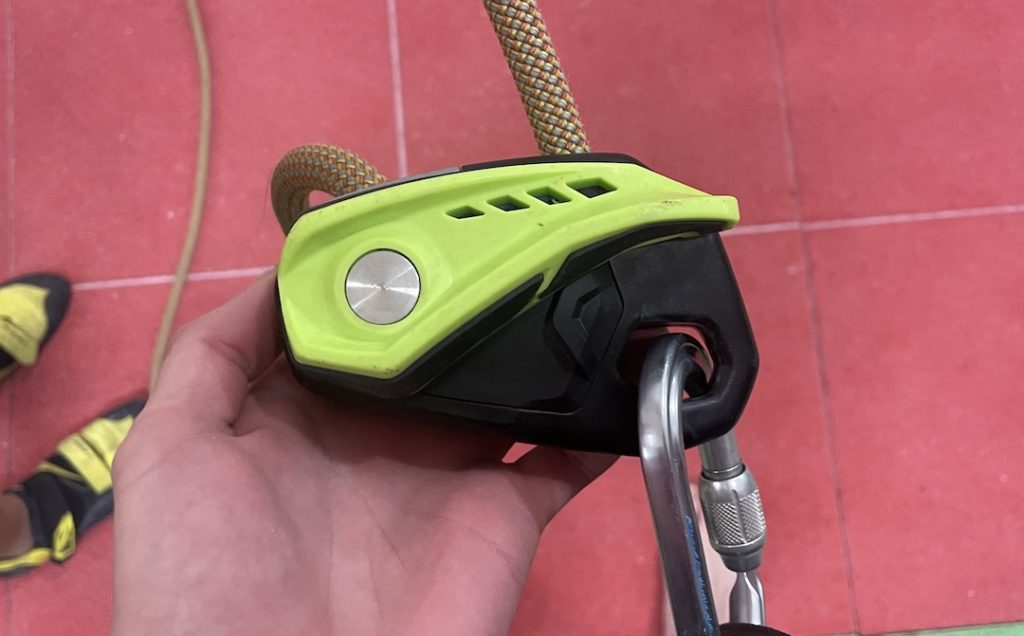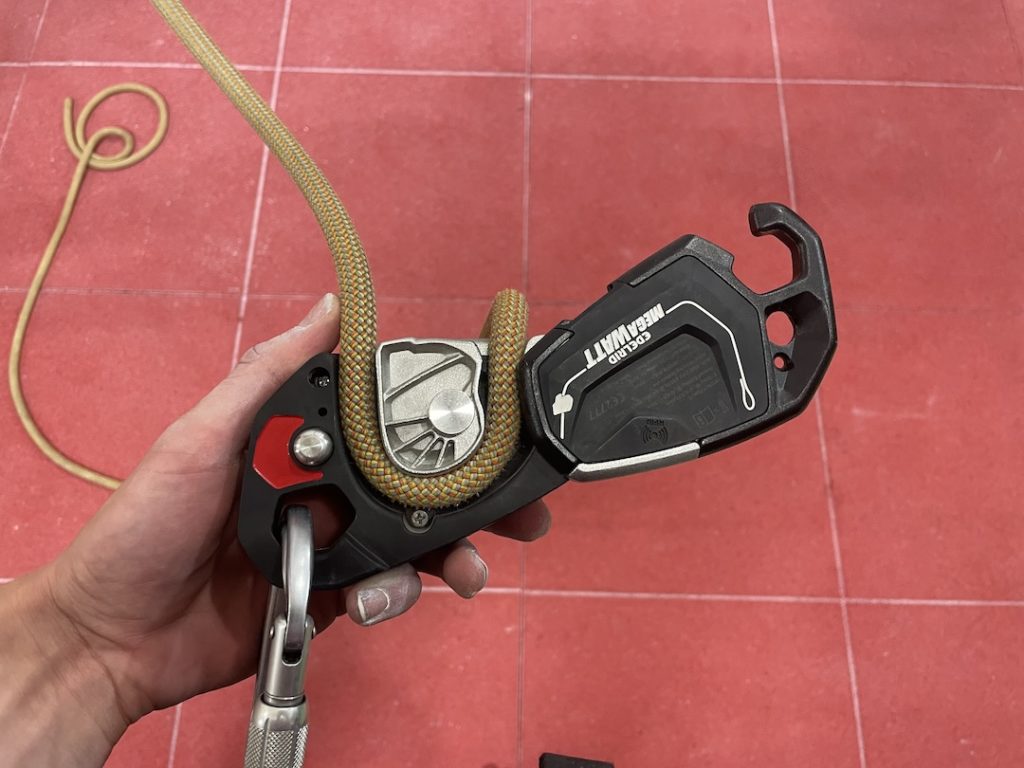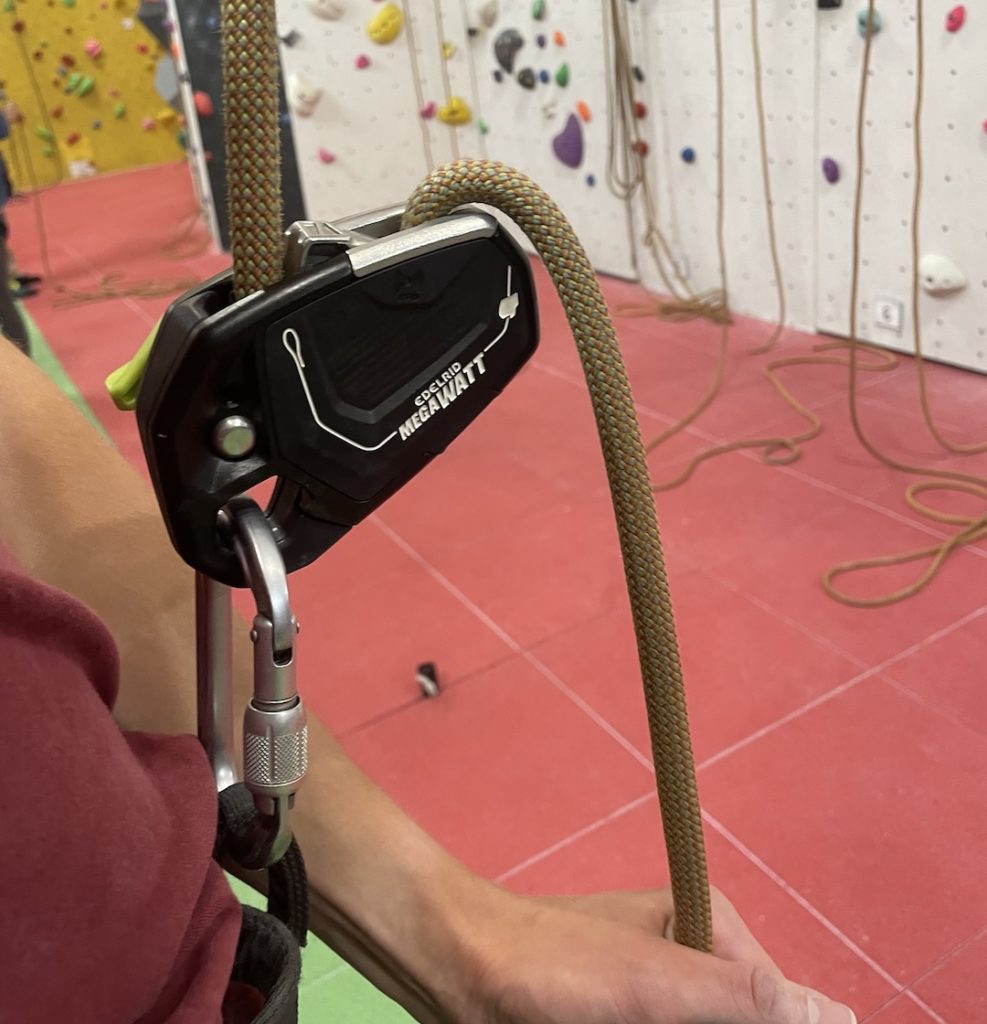As with all the content on this website, we’re providing you with our opinions. Your safety is still your responsibility, and we will not be held responsible for any consequences arising from the use or misuse of information contained here, howsoever caused.

The Bottom Line
The Edelrid Megawatt is a descender rated for professional use in rope access or similar disciplines. But in some cases, it can be a great choice as a belay device for sport climbers, too – if you can justify the price tag.
This is not a review of the device as such – it’s a look specifically at using this device for climbing. I’ll share some of my experience from the last year or so that I’ve been using the Megawatt as my main belay device for climbing, and compare it to the Petzl Grigri.
Pros:
- Solid catch and easy hold – great when your partner is trying something difficult.
- Excellent for teaching or supervising
- Easy rope changes
Cons:
- Expensive for a belay
- Heavy
Purchasing
The Edelrid Megawatt retails for £175 in the UK, though discounts are often available from retailers. Being quite a niche device, you’ll have to get it from a rope access specialist, such as Rope Access Equip or Abaris (not affiliates – I just like them).
In Use
The device handles extremely well as a climbing belay device, with a few important caveats and some specific use cases.
Edelrid Megawatt vs Petzl GriGri
This is probably the most important comparison to make when deciding whether or not to buy a Megawatt. It looks cool and it’s robust, but is it actually better than a GriGri? Or what about a GriGri+?
1. Cam
To answer that, we first need to look at the main structural differences between the Edelrid Megawatt and the GriGri. The most significant difference is the cam: in the GriGri, the device locks when tension in the rope lifts the entire back half of the device and it pinches the rope. In the Megawatt, however, the cam is a much smaller piece that rotates about its centre. In practice, this means that the rope changes length when the GriGri catches (the rope moves with the cam – one of my least favourite features of the GriGri). On the Megawatt, however, it doesn’t – which makes for a much smoother belay.

2. Lowering
Second on the list of differences is the lowering handle. On the GriGri, you pull towards you, where in the Megawatt you pull away. The Megawatt also has an anti-panic feature (like the GriGri+ but not the standard model) and, in addition, a second lowering mode where you lift the handle up to lower rather than pushing it down: this is extremely useful for one-handed operation. The design of the cam and the way the handle is spring loaded on the Megawatt makes for an incredibly smooth lowering experience that the GriGri simply can’t match.
3. Setup
The final difference I’ll look at that impacts climbing is how you get the rope into the device: on the GriGri, you have to take the device off the carabiner to open the side, whereas on the Megawatt you can open the device while it is attached to your belay loop (but, obviously, it can’t be opened under tension). Other than the convenience, this has one major use case which I’ll come back to later.
Climbing Styles
Because of the difference in cam design, the Megawatt provides a much more solid belaying experience than other devices I have tried. It is quick to lock when the rope is under tension, and easy to release when the climber keeps climbing. For this reason, it is my preferred device for belaying top rope. It makes the process effortless and is really secure.
The picture is slightly different for lead, however. Because the cam is so quick to lock, there is a knack to giving out the large amounts of slack you need to allow your partner to clip. The shape of the device means that, unlike the GriGri, there is no simple way to hold the device while managing the brake strand with one hand, leaving the other free to pay out slack – and you can’t just feed slack through the device with two hands (like with the Petzl Neox) because the cam will lock.
I have found a compromise technique, though. It is possible to hold the device with one hand and feed the brake strand between the device and your palm, leaving a thumb free to keep the cam unlocked. This then leaves the other hand free to pay out slack. It works, and I have caught many falls using it without problem, but it is not part of the manufacturer’s recommended use – so be careful. That being said, when I’m belaying lead I usually still reach for my trusty tubular belay device.

Specific Use Case: Teaching
There is one specific use case where the Megawatt really stands out from other devices that I’ve seen: and that is when teaching or supervising inexperienced climbers. Because it is robust and very quick to lock, it provides a reassuring belay experience for people who are doing their first top ropes and aren’t yet used to being so far off the ground when climbing.
I’d still recommend teaching belaying using a tubular device (I feel it helps new belayers to get used to the feel and principles of belaying), but the Megawatt also makes an excellent secondary belay device for the supervisor to use. I feed the rope through their belay device in the usual way, then through the Megawatt (obviously leaving slack for them to belay properly). I have found that this often helps new belayers (and the people they’re belaying) to feel confident, and it certainly reassures me that if something does go wrong the climber is still safe.
Another use case takes advantage of the fact that you can insert the rope without unlocking the carabiner. This makes it possible to safely take over from another belayer while somebody is climbing, which has been helpful in some situations. Obviously, that really isn’t recommended – so don’t do it unless you have to and you know what you’re doing.
Conclusion
The Edelrid Megawatt is my current go-to belay device, and lives on my harness along with a tubular belay device. That being said, other belayers sometimes find it too aggressive on the catch, which I can understand – so, if possible, try before you buy. If you spend time teaching people how to climb, though, I would definitely give it a go!
Note: Clearly, none of this is advice. Edelrid do mention belaying with the Megawatt in the owner’s manual, but it is primarily a descender – always use gear to the manufacturer’s specifications and be careful. Getting it right is your responsibility.

